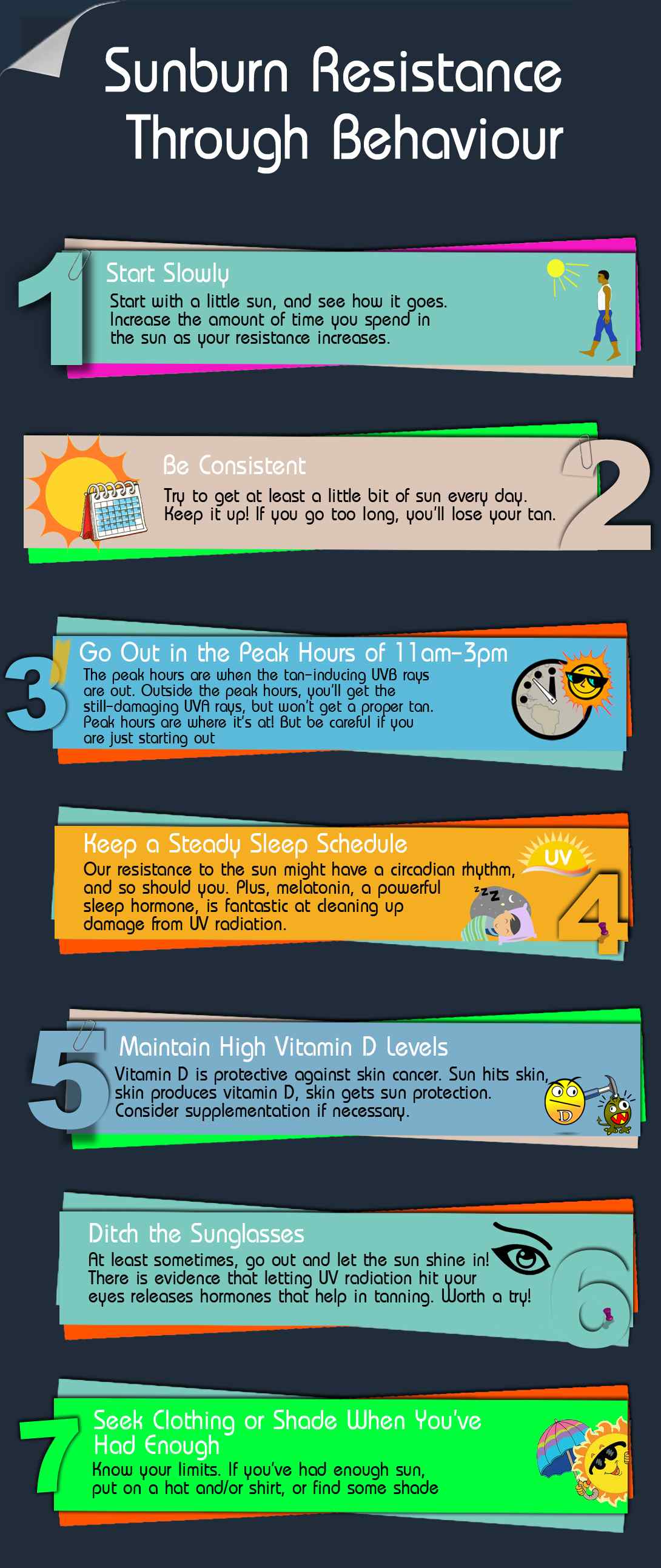Introduction
The last post in this series was quite a hit! In that post, the focus was how to use your diet to increase your resistance to sunburn so that all the benefits of sunlight could be obtained, while minimizing any negative effects. With the right diet, even the palest gingers among us can improve their resistance, and gradually build up a tan and abandon the use of sunscreen, or really cut back on its usage (and I’d stick to physical sunscreens over chemical).
That’s all well and good (great even!), but even the best diet won’t make some of us sunburn immune. I live in Vancouver, BC, Canada, where the sun barely shines for five months of the year (we have rainy winters here). Even when the sun does peak out during the winter, it is too low in the sky to provide any appreciable sunburn causing (and vitamin D producing) UVB radiation, in addition to us being all bundled up with clothing anyway (exception: new year’s day polar bear swim, which I have not yet participated in). After a couple of months of Vancouver weather, the body’s adaptation to the sun’s radiation (sun tans) are gone. To people living in the higher northern/southern latitudes, this is a very familiar process. In the absence of artificial tanning or a tropical winter vacation, we all get a little paler and less sunburn resistant in the winter (some more so than others). It’s best to build up resistance over the spring and then maintain this resistance during the summer.
As I explained previously, improving your diet will naturally improve your sunburn resistance. However, even with the best diet, some of will get sunburned if our sun exposure habits are inappropriate. I still believe that a proper diet will reduce the severity of the burn, and the recovery time, but you’ll still get burned. And severe sunburns are not healthy. That being said, avoiding the sun entirely is also unhealthy, and chemical sunscreens aren’t helping much either. It’s best to build our resistance naturally, through diet AND behaviour.
So, what sun exposure behaviours are going to help us build and maintain an awesome tan?
Below is a summary infographic, followed by a deeper explanation.
Sunburn Resistance Through Behaviour
1. Start Slowly
This is wise for any type of endeavour, sunburn resistance included. As an analogy, let’s think about exercise. Exercise is undoubtedly healthy, but if you spend six months on the couch surfing Netflix, and then get up and attempt double bodyweight squats or running a marathon, you are going to get hurt. Likewise with the sun – if you stay indoors all winter, and then hit the beach in early summer and expose your full body to six hours of intense sunlight, you are asking for a nasty sunburn.
So, if you consider yourself very prone to burning or it has been a long time since you’ve been exposed, start with 10 minutes out in the sun, and see how that goes. I bet you’ll feel great! If that goes well, next time try 15 minutes, and so forth. You’ll start to build up a tan, and will be able to handle more as time goes on. Eventually, you’ll wonder why you ever used sunscreen.
2. Be Consistent
This is consistent with #1. To keep from losing your tan, you’ll have to expose yourself to the sun regularly. Again, this is like any skill. If you hit the gym once a month, you are not going to get stronger. All you will get is soreness and a lack of progress. You have to do it more often and consistently. When it comes to sunlight, try to get at least some everyday. As with all things, it’s more about quality than quantity.
3. Go Out in the Peak Hours of 11am-3pm
To develop an effective tan, and to produce vitamin D, you need to expose yourself to UVB radiation. For UVB radiation to hit the earth’s surface, the sun has to be angled high in the sky. Otherwise, ozone in the atmosphere absorbs all the UVB, while letting all the UVA through unencumbered. Even during the summer, UVB from sunlight is only available in any appreciable quantity during peak hours: approximately 11 am to 3 pm during late spring, summer, and early fall (assuming you live in the mid latitudes and not the tropics). This window is smaller if the date is further from the summer solstice (June 21 in the northern hemisphere), and eventually might close at some point approaching the winter, depending on the latitude where you live (in reality, it may only be polar winter conditions that have zero UVB).
Outside the peak hours, and even during the winter, there is still a lot of UVA radiation, but this type of radiation doesn’t produce vitamin D, or induce an effective tan. You’re “getting sun”, but it’s not effective sun for the benefits. Quality over quantity! A small amount of time during the peak hours is superior to more time during the off-peak hours. Researchers in 2008 reached this same conclusion. The problem is that most of us are bound to our indoor cubicles during these hours. Walking to and from work is great, but you’re not getting much effective sun at 8 am and 5 pm, even in the summer.
And so I suggest – if you can manage it, go outside every day during peak hours and get some sun. If we all do it, then no one is slacking off. It’s good for you, and should be as encouraged as exercise and healthy food. If I’m in charge, that’s the rule.
4. Keep a Steady Sleep Schedule
A steady sleep schedule is healthy in many, many ways and is of primary importance to our overall health. I’ve talked about our natural sleep schedule (our circadian rhythm) and the sleep hormone and antioxidant melatonin before. With respect to our resistance to sunburn, a steady sleep schedule helps in two main ways:
First, our resistance to sunburn may have a circadian rhythm. This means that at certain times during the day we are more resistant to sunburn than at other times. Jamie Scott (aka ‘That Paleo Guy‘) has previously written on this matter. He quotes a study on mice called “Control of Skin Cancer by the Circadian Rhythm” where they posit that a certain protein responsible for repairing UV damage shows a circadian rhythm in its repairing effectiveness. In mice, the protein was most effective in late afternoon. Mice exposed to UV radiation at 4 am got five times the amount of tumours as mice exposed to UV radiation at 4 pm. This showed that the time of day of exposure has an impact on the net amount of damage incurred.
For humans, the circadian rhythm is reversed, with the UV-repairing protein being more effective in the morning than later in the day. Researchers thus predicted humans would have the greatest capacity to repair UV damage in the morning hours. So, those peak hours count and perhaps it’s best to get the earlier of the peak hours even!
Second, having a steady sleep schedule will result in superior melatonin secretion, and melatonin is a powerful antioxidant that is very efficient at mopping up free radicals in the skin from UV-damage. So, as I explained in Sleep Series Part 3, getting sunlight during the day, and then avoiding light (especially blue-light) before bed promotes proper melatonin production. This has many benefits, including cleaning up skin damage from the sun. It often seems as though the body has thought of everything, doesn’t it?
5. Maintain High Vitamin D Levels
Vitamin D has been quite the buzz-vitamin for a while. It does all sorts of great stuff including calcium absorption, immune system function, and modulation of cell growth. Vitamin D is produced in your skin when it is irradiated with UVB radiation. UVB radiation is also what people are so concerned about when it comes to skin cancer. Luckily, vitamin D in the skin protects against non-melanoma skin cancer and potentially melanoma as well. So let’s see: UVB hits skin and produces vitamin D which then goes on to perform a variety of functions including protecting the skin from UVB damage. Pretty slick system Mother Nature!
Logically, it could be suggested that some vitamin D supplementation in the winter could help with sun protection in the spring when our tans are down. That being said, starting slowly and building up vitamin D and a tan should also work just fine.
6. Ditch The Sunglasses
At least some of the time, go outside and expose your eyes to bright daylight without sunglasses. Don’t look directly at the sun, but be out and about allow some sunlight (UV radiation included) to hit your eyes. In a previous post in the Sleep Series, I’ve talked about how bright light in your eyes will produce serotonin, which goes on to be converted to melatonin (which, according to tip #4, will mop up a lot of the free radicals from sun damage). On top of that, research has shown that UV radiation entering the eye causes, through a cascade of hormones, the production of melanocyte-stimulating-hormones that stimulate the production of the melanin pigment (a tan) in the skin. Dr. Sharon Moalem examines this effect in his book “Survival of the Sickest“. Skin can tan without light entering the eye, but the idea is tanning happens faster when your eyes tell your brain how bright it is outside.
If sunglasses really do cause worse sunburns via less melatonin production, it’s another example of how too much shielding from natural environmental stressors limits our adaptations to these stressors, making us weaker as a result. I don’t wear sunglasses myself unless it’s an extreme situation (playing sports near sunset usually). I never really have worn sunglasses, even before I knew anything about the effects. It’s not that I’m completely against them, but I feel I don’t need them and I don’t like wearing things on my face. I like it when it’s bright out! Now, I recognize for a lot of people, sunglasses are a cool and stylish addition that they won’t want to ditch, but I would advise at least some daily time outside without them for both better sleep and better tanning.
7. If You’ve Had Enough, Put On A Shirt, or Seek Some Shade
This might be the simplest advice of all, and really doesn’t require citing a scientific study. Simply put, if your skin is starting to turn pink and tender, put on some clothing to protect it from the sun, or find some shade. No sunscreen required, and you’ll come back with a tan and be able to stay out longer. Do this a few times early in the sunny seasons, and you’ll surprise yourself with your built-up resilence.
Conclusions:
Having a diet based on refined foods and getting little sun and then blasting yourself on a tropical vacation once a year will indeed result in a bad sunburn and quite a bit of damage. That being said, combined with an appropriate diet, the above sensible-sun behaviours will provide the benefits of the sun while minimizing the harm. I certainly don’t fear the sun anymore, and truly enjoy fitting in some exposure whenever I can. Remember to start slow, be consistent, go out in the peak mid-day hours, keep a steady sleep schedule, maintain high vitamin D levels, ditch the sunglasses sometimes, and if you need to, put on some clothing or find some shade to protect yourself.
Readers: You will surprise yourself with your sunburn resistance when the right diet is combined with the above sun-exposure behaviours.
Has anyone experienced a significant improvement in their resistance to sunburn? Please comment below.
See you on the beach,
Graham

